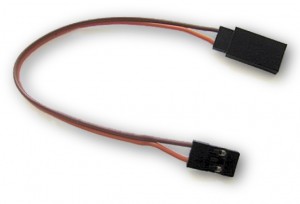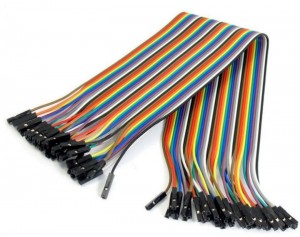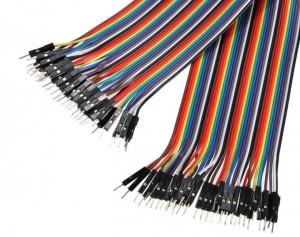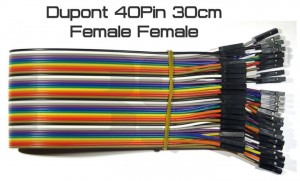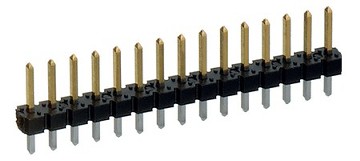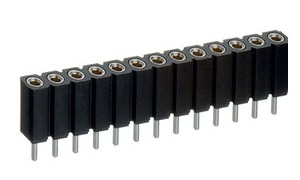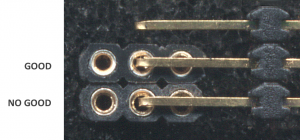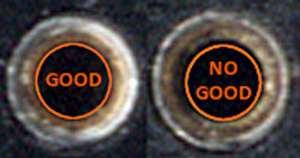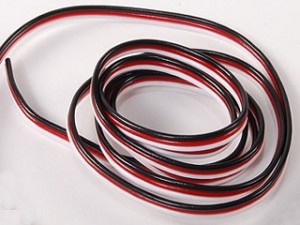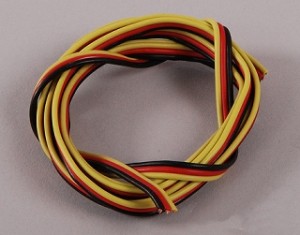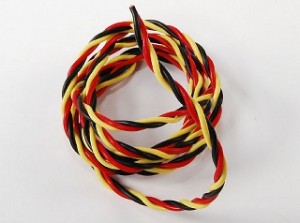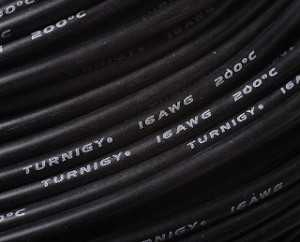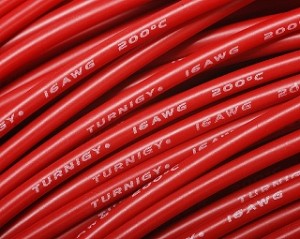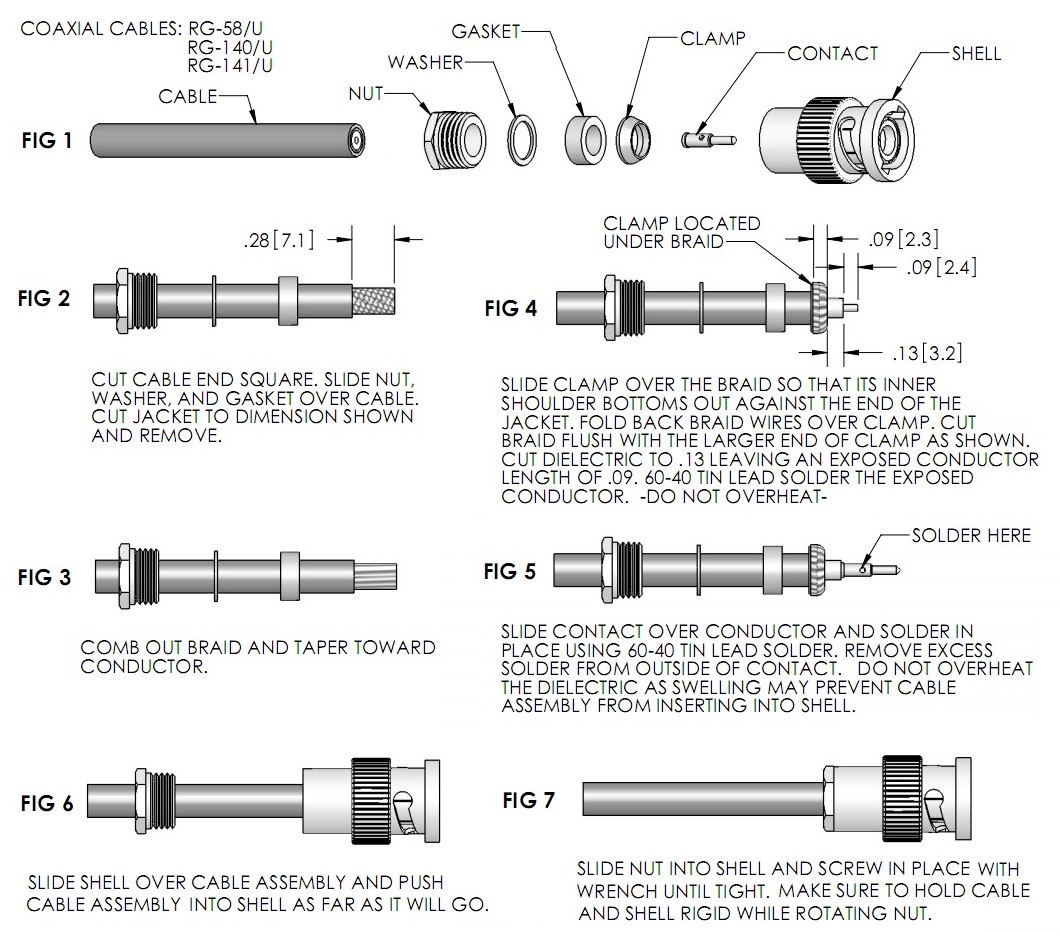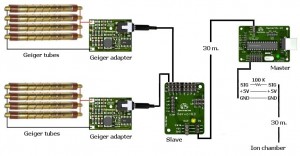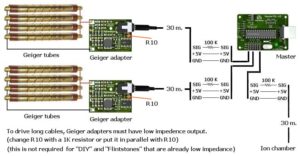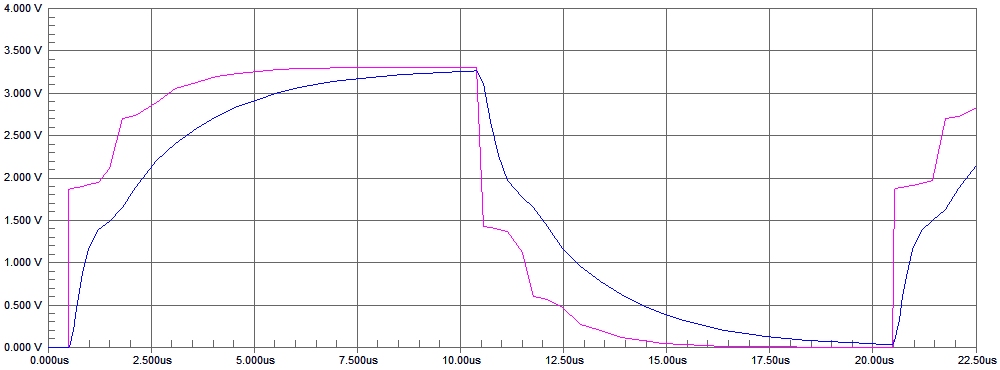Tables AWG – Diameter of wires and electrical characteristics
AWG Table “metric”, in PDF format: AWG Table MKS
AWG Table “Imperial”, in PDF format: AWG Table Imperial
Standard cables with male and female connectors
Yellow = Signal Red = + 5V Brown = Gnd
With soft wire of good quality from 26 AWG (0.13 mmq – up to 0.5 Ampere)
Cable soft – 26AWG – 15cm long – Pack of 10 pieces – about 2.5 Euro
www.hobbyking.com/hobbyking/store/__9697__15CM_Servo_Lead_Extention_JR_26AWG_10pcs_bag_.html
Cable soft – 26AWG – 30cm long – Pack of 10 pieces – about 2.5 Euro
www.hobbyking.com/hobbyking/store/__9685__30CM_Servo_Lead_Extention_JR_26AWG_10pcs_bag_.html
Cable soft – 26AWG – 60cm long – Pack of 10 pieces – about 3 Euro
www.hobbyking.com/hobbyking/store/uh_viewItem.asp?idproduct = 9687
Eye closure from 26 AWG (0.13 mmq – up to 0.5 Ampere)
Cable soft – eye closure – 26AWG – 15cm long – Pack of 5 pieces – about 1 Euro
www.hobbyking.com/hobbyking/store/uh_viewItem.asp?idproduct = 20958
Cable soft – eye closure – 26AWG – 30cm long – Pack of 5 pieces – about 1.4 Euro
www.hobbyking.com/hobbyking/store/uh_viewItem.asp?idproduct = 20959
Twisted wires from 22 AWG (0.33 mmq – up to 1 or 2 Ampere)
Cable twisted 22AWG 15 cm of length supplied in 5 pieces – about 1.5 Euro
www.hobbyking.com/hobbyking/store/__9777__Twisted_15CM_Servo_Lead_Extention_Futaba_22AWG_5pcs_set_.html
Cable twisted 22AWG 30 cm of length supplied in 5 pieces – about 2 Euro
www.hobbyking.com/hobbyking/store/__9773__Twisted_30CM_Servo_Lead_Extention_Futaba_22AWG_5pcs_set_.html
Cable twisted 22AWG from 60 cm in length 5 pieces – about 2 Euro
www.hobbyking.com/hobbyking/store/uh_viewItem.asp?idproduct = 9711
Rediculously, It is good to buy a lot and get used to sacrifice.
When you cut them in half to solder connections are needed. On the one hand you peel and are welded, on the other side, you exploit the connectors. Influence people with loose connectors, It would cost more, It wouldn't be as strong.
Cable without power
Cable soft without power (Battery Eliminator) by 18 cm in length supplied in 1 pieces – about 0.5 Euro
http://www.hobbyking.com/hobbyking/store/__21496__185mm_BEC_Eliminator_Cable.html
Individual cables on eBay
Single connector cables, may be useful in some cases (for example the 3.3 Volts stabilized by the ICSP connector). There are three types: usually you use those male-female, but sometimes you need the male-male or female-female.
Rediculously, It is good to buy a lot and get used to sacrifice.
When you cut them in half to solder connections are needed. On the one hand you peel and are welded, on the other side, you exploit the connectors. Influence people with loose connectors, It would cost more, It wouldn't be as strong.
These cables are found on eBay, as flat cables from 10 or from 40 wires. Are long 20 or 30 cm and cost about 10 cents, for each wire.
The links we offer, probably become invalid shortly, but they are equally useful, to show the words to search on eBay:
10x-Cables-Dupont-20cms-Femelle-Femelle
10x-Cables-Dupont-20cms-Male-Male
10x-Cables-Dupont-20cms-Male-Femelle
40x-Cable-Dupont-30 cm-Femelle-Femelle
Pitch connectors 2.54
From version 3 on the system Theremino has abandoned the screw connectors, so beautiful to look at but uncomfortable and unreliable.

Screw connectors require a small screwdriver and it's easy to over tighten, ruin the small screw or cutting the wires, If you shake a little time and vibrations can loosen the wires and start producing false contacts, hard to find. And’ also easy, When are many, forget to make one that might make contact in all tests but give problems right in the most inopportune moment. All these things have happened with earlier versions so now we use only connectors “Strip” gold-plated, good quality.
Connectors “Strip”
All connectors used in your system Theremino are of type “Strip” with step 2.54 mm, the same thousand-whisker holes, in order to facilitate modularity and creating adapters.
Normally male-female extension cables are used but in some cases it may be useful to have male and female sockets to be welded.
The connectors “Strip” males are all okay – just that they are golden.
http://www.distrelec.it/it/Connettore-a-pettine-8-poli-1-x8P-Preci-Dip-890-18-008-10-803/p/14383938?q=spinotti+a+pettine&page=29&origPos=29&origPageSize=10&simi=93.31
The connectors “Strip” female must be of good quality, otherwise cause false contacts from new and a lot of problems later. Do not underestimate this problem, almost all female connectors work very badly, the good ones are distinguished by holes that are not square but round. Only the “Turned Connectors” are fine.
Until recently, the connectors were turned from Distrelec, but now it seems that they removed from the catalog. With a little’ We found them by visiting researcher and research Precidip.
Distrelec 120591 (female connector, right – currently out of print)
http://www.distrelec.it/it/…Socket-female….
Visiting researcher (2.54 mm pitch turned female connectors)
http://www.adimpex.it/……NPD057……..
RS (Currently – July 2016 – They also sell from RS)
http://it.rs-online.com/web/p/zoccoli-sil/7022741 – 2 vie – 0.198 Euro
http://it.rs-online.com/web/p/zoccoli-sil/7022754 – 3 vie – 0.278 Euro
http://it.rs-online.com/web/p/zoccoli-sil/7022751 – 4 vie – 0.322 Euro
http://it.rs-online.com/web/p/zoccoli-sil/7022763 – 5 vie – 0.282 Euro
http://it.rs-online.com/web/p/zoccoli-sil/7022776 – 6 vie – 0.498 Euro
http://it.rs-online.com/web/p/zoccoli-sil/7022782 – 7 vie – 0.574 Euro
http://it.rs-online.com/web/p/zoccoli-sil/7022789 – 8 vie – 0.636 Euro
http://it.rs-online.com/web/p/zoccoli-sil/7022791 – 9 vie – 0.726 Euro
http://it.rs-online.com/web/p/zoccoli-sil/7022802 – 11 vie – 0.636 Euro
http://it.rs-online.com/web/p/zoccoli-sil/7022805 – 10 vie – 0.798 Euro
http://it.rs-online.com/web/p/zoccoli-sil/7022814 – 12 vie – 0.938 Euro
The manufacturer is Precidip
http://www.precidip.com
This page list all models Precidip, per Pin from 0.76 mm
http://www.precidip.com/en/Products/PCB-Connectors/pview/801-PP-NNN-10-001101.html
For those wishing to find other retailers, search words are:
Turned Female Connectors
Female bar single row
Step 2.54 mm
Pin diameter 0.76 mm
Plastic height 7 mm
Total height 10 mm
The strips of connectors are quite expensive, females good cost 10 to 20 cents for each contact, to spend less you can buy long strips 20 or 50 contacts and then cut them. You should be careful that they break bad for which you have to pre-cut into them with a utility knife and then use two clamps suitable.
Female Strip-fake
We thought that all female strip with round holes were all good, but they managed to tweak even those!
In the images we see little difference, but putting a pin male feels that are different. The good ones will creep so reassuring, in others the male dance inside, and If you put a pin only and turn on the contrary, the pin slips out by sheer force of gravity.
Probably not the diameter of the hole that counts but the type of spring that's inside. The good ones have a spiral spring, others probably have only one blade on one side.
Buy only from reputable retailers and check them before using them. To control them slamming a single pin occurs to extract it you have to pull a little. If it slips off virtually alone then the female strip is not good and will make a precarious contact. If they aren't good ones, then you better delete them and solder the wires directly, or weld male pins on the PCB, and use female female cables for connections.
Long wires and currents up to 1 – 2 Ampere
Three-wire cables (without connectors)
26Soft silicone AWG 26AWG normal
22AWG 22AWG twisted
3-wire flat 26AWG soft silicone (black/orange/yellow) – about 0.8 Euro per meterhttp://www.hobbyking.com/hobbyking/store/__5491__Flat_26AWG_servo_wire_1mtr_R_O_B_.html 3-wire flat 26AWG (black/orange/yellow) – about 0.3 Euro per meter
http://www.hobbyking.com/hobbyking/store/__5492__Flat_26AWG_servo_wire_1mtr_R_B_W_.html 3-wire flat wire 22AWG (black/orange/yellow) – about 0.8 Euro per meter
http://www.hobbyking.com/hobbyking/store/__6904__Flat_22AWG_servo_wire_1mtr_R_B_Y_.html 22AWG twisted cable (black/orange/yellow) – about 1 Euro per meter
http://www.hobbyking.com/hobbyking/store/__5489__Twisted_22AWG_servo_wire_1mtr_R_B_Y_22AWG.html
- For currents up to 0.5 Amps use 26 AWG (0.13 mmq)
- For currents up to 1 or 2 Amps use 22 AWG (0.33 mmq)
Cables for currents greater than 2 Ampere
Both for transmission line that connect the sensors when you handle currents over one or two amps can no longer use standard cables with male-female connector.
For currents up to 5 Ampere is necessary to use single wire from about 20AWG (0.52 mmq)
Black wire pure silicone for free “Massa” 20AWG – about 0.6 Euro per meterhttp://www.hobbyking.com/hobbyking/store/__9654__Turnigy_Pure_Silicone_Wire_20AWG_1mtr_Black.html Pure silicone thread per connection “+5V” 20AWG – about 0.6 Euro per meter
http://www.hobbyking.com/hobbyking/store/__9652__Turnigy_Pure_Silicone_Wire_20AWG_1mtr_RED.html
For higher currents, up to 10 Ampere, using single wires from 16AWG (1.3 mmq)
Black wire pure silicone for free “Massa” 16AWG – about 1 Euro per meterhttp://www.hobbyking.com/hobbyking/store/__9680__Turnigy_Pure_Silicone_Wire_16AWG_1mtr_BLACK.html Pure silicone thread per connection “+5V” 16AWG – about 1 Euro per meter
http://www.hobbyking.com/hobbyking/store/__9681__Turnigy_Pure_Silicone_Wire_16AWG_1mtr_Red.html
For the signal does not need a lot of power that you always use a yellow wire from 24AWG (0.2 mmq)
Yellow silicone thread per connection “Signal” 24AWG – about 0.5 Euro per meter http://www.hobbyking.com/hobbyking/store/__10939__Turnigy_Pure_Silicone_Wire_24AWG_1mtr_Yellow.html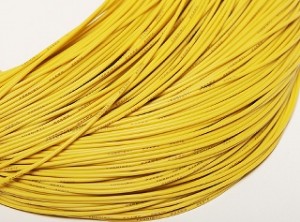
BNC Connectors
There are some really tough BNC to assemble without any instructions.
It would be better to use other patterns easier to assemble (with the special pliers) but, If you really must, Please follow carefully the instructions in the next image (Click the image for a larger view)
Long links
Here he talks about the connection between the pins and sensors. For recommendations on the serial connection between the Master and the Slave, read the the following section. For Geiger Adapters also read This page.
The sensors are connected to the pins of the Master (or of a Slave) with extension cords male female, no screens, that you normally use for all links in the system Theremino. If required you can connect multiple extension cords, from 60 cm, in series and get up to a few meters away.
For longer distances you have to use a shielded cable. Microphone cables with two wires red and white interior, are great, are robust and have the tear-resistant rope. Maximum shielded cable length is 500 meters and beyond (provided you follow the following guidelines).
With long connections you should use sensors with low output impedance and an end-of-line resistor to protect Theremino Pin from overvoltage.
1) With long links (beyond the 20 meters) the sensors must have impedance (resistance in series with the output signal) not more than a few Kilo Ohm. To link Geiger Adapters Read here.
2) Add a 100 k resistor in series with the signal wire, at the end of cable, within a few centimeters from the Master. Attention: These resistors from 100 k you bring only on pins configured as Input (ADC, DigIn and similar). You do not need to add resistors to Output Pin, or even worse to the serial line, connecting the Master with the Slaves.
In these two pictures you can see examples of connections with long cables. The version of the right image requires more meters of cables, but it is more immune to interference. The second version is even cheaper, given that the Slave is not required. In general less components and modules are used, the greater the reliability of a system.
3) Do not connect low-impedance output sensors (output voltage greater than 3.3 Volts) a Pin without additional resistor 100 k. That happens by mistake doesn't break anything but the 5 volt voltage, limited current not the resistor, may cause frequent loss of USB communication.
4) Avoid routing the cable in the same pipes (or cable ducts) the electrical system. Avoid strokes outdoors, about flying or spans on poles. The strokes outdoors must be protected with metal pipes, grounded, and masonry. The areas that should be on top, for example on a roof, must be protected from the Sun with canopies (many sensors over the 50 grades go crazy). Metal sheds should be grounded for Lightning.
Long serial connections and noise immunity
Here we talk about the serial connection between the Master and the Slave. For recommendations about the connections between pins and sensors, read the previous section.
DPM Protocol, used for serial communication, allows connections up to 10 km. For short distances (under 5 meters) does not require any special precautions while for longer distances you should check the following points.
Protect the communication line from electrical noise
– Run the cable channels separate from those of the electrical system.
– Avoid running the cable near transmitting antennae of great power.
– Use twisted cable (twisted)
– Use shielded cable.
– Add filters R/C (resistance and capacitor) at the beginning and at the end of the line.
– If the current transmission path also leads to the modules use a ground wire of large section.
– Delete the currents on Earth by optical isolation.
In a normal system not all these measures are needed, the system designer should assess on a case by case basis what precautions taken to avoid transmission errors and, in extreme cases, damage of the components.
Avoid that line of communication radio communications disorders
– Use twisted cable (twisted)
– Use shielded cable.
– Add filters ferrite toroidal at the beginning and at the end of the line.
– Add filters R/C (resistance and capacitor) at the beginning and at the end of the line.
The System Designer must consider, Depending on the type of application, legal limits on emissions RF energy evaluate case by case What precautions taken.
Basic filters R/C
Theremino system modules contain a basic filter for radio interference and overvoltage protection up to a few tens of volts. More aggressive filtering would limit the performance in some cases and would not be enough in other.
This image shows a transmission line composed 100 meters shielded cable RG58 (50 ohm resistor) usable up to speed 7 (100 Kbps)
The two resistors 120 ohm resistor, What are the standard resistors in all modules of the system Theremino, provide basic protection against sufficient in most cases. Since the cable capacity increases with the length of these resistors produce a cutoff frequency that automatically adapts to all situations.
Additional filters R/C
Normally are not required additional filters, the mere fact of using a shielded cable can reduce emissions to virtually zero.
In the case that the laws and the type of installation so require you can get a low pass extremely effective by adding a resistor and a capacitor at the beginning and end of the line as shown in the following image.
The resistors from 120 ohm are already present in Theremino system modules that are not part of the R/C filter-on.
Additional filtering components, which in this example are 50 ohm and 2200 pF, they are not self-adapting teaching as those of the Theremino, and then must be sized suitably according to the length of the line, the cable type and speed that you intend to use.
The resistance value must be approximately equal to the characteristic impedance of the cable, In this case 50 ohm resistor. The capacity value is to be calculated so that at maximum expected throughput signal faces remain steep enough not to cause transmission errors.
In this picture you see a signal from 100 Kbps deteriorated from 100 meters of RG58 cable, the red line shows the signal with just a resistor 120 ohm basic protection, the blue line shows the effect of adding filters R/C 50 ohm and 2200 PF at the beginning and end of line.
With the filters up and down time is slightly greater but remains sufficient to reach the 90% maximum tension in about half the cell (100Kbps = cell to 10uS)
On the other hand, with filters, due to reflections about 500 NS decay time the signal takes to the 100 meter cable, I completely deleted and the signal does not contain unnecessary high frequency components that might create radio interference.
Maximum cable lengths in relation to transmission speed
To calculate the maximum length of the connection cables serial, see the tables in the communication protocol here: https://www.theremino.com/technical/protocol#times
Characteristics of shielded cables
The values of “maximum length”, shown in the preceding table, are valid for cables with a capacity of about 100 PF per meter. The table with the corrections to be applied for the most commonly used cables are here: https://www.theremino.com/technical/protocol#capacity
Maximum cable length of communication than the supply current and resistance per meter
If you are using the serial cable to power the modules Slaves with considerable currents, to calculate the maximum length of the connection cables, see the tables in the communication protocol, here: https://www.theremino.com/technical/protocol#maxlen
Time delays due to the distance
Into the void
300 000 Km/s ( 300 Mt / uS )
Then 100 m = 334 NS
For cable
From 50% at 75% the speed of light in a vacuum
then 100 Mt = 500 NS about.
Current and voltage on connectors
The current output by connectors depends on configuration of the system, by the number of “slaves” and how it is configured each.
Absolute maximum for each Pin
Power supply ( +5V ) : up to 500mA
Signals ( 0 to 3.3 V ) : up to 15mA
Absolute maximum for each Slave
Feeds ( +5V ) : up to one ampere
Absolute maximum per group (which is headed by a Master)
– up to 500 But if you use the standard USB power
– up to 1 If you use the USB charging with two connectors
– up to two amperes when using an external power supply 5 V 2 A
In the event that the total current is not sufficient you can break the communication line keeping joined the power but reading wire separating that multiple trunks. Each trunk will be served with a wire coming from a 5V 2A power supply, or all the wires will head to a single 5V power supply capable of withstanding the total current (10To or more).
3.3 V voltage is generated locally by a precision controller and is stable within +/-10 MV, noise is superimposed by 200 to 500 UV depending on how much is silent the USB power mains.
The 5V voltage comes directly from the USB and can range from 4.5 V to 5.5 V, with a fairly high noise (100 MV and beyond) in the band from 1 Hz to 100 kHz.


